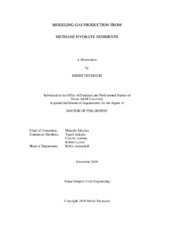| dc.description.abstract | Constitutive modeling of gas production from methane hydrates, as the largest source of hydrocarbons on Earth, is one of the challenging topics in the field of Energy Geotechnics. Methane hydrates are solid compounds made of water molecules clustered around methane gas molecules. The ice shaped methane hydrates form under specific conditions of high pressure and low temperature that are common in sub-permafrost layers and in deep marine sediments. Methane gas is produced from hydrate bearing sediments (HBS) as a valuable energy resource based on releasing the molecules of gas from lattice components of hydrate with the aid of depressurization, heat and/or chemical stimulation. Coupled thermal, hydraulic, chemical and mechanical (THCM) analyses are necessary for realistic simulation of this complex phenomenon since hydrate dissociation comes with interrelated THCM processes. In this study, a numerical code based on a general mathematical formulation is used to analyze coupled THCM problems involving gas hydrate bearing sediments. It takes into consideration thermal and hydraulic processes, effective stress and the change in sediment properties in the presence of hydrates. This fully coupled formulation incorporates the different phases existing in HBS (including hydrate and ice) and has been implemented in CODE_BRIGHT, an existing coupled multi-physics program for geological media.
An analytical solution is also proposed for the steady state condition involving fluid flow in a cylindrical geometry and accounting for the presence of two zones of different permeability coefficients. This solution can be very useful in problems encompassing HBS since it can determine the depressurization zone of influence, which paves the path to define realistic boundary conditions in the numerical simulation. Furthermore, the effect of crucial parameters on hydrate dissociation, induced by depressurization, are investigated by both constitutive modeling and analytical solution.
Beside the comparison between the outputs of the numerical analysis with the corresponding analytical solution, which are satisfactory compatible, the presented numerical formulation has been verified by some of the previous experimental data. The numerical simulations successfully capture the coupled processing associated with the hydrate dissociation/formation reported by the experiments and address the characteristic behavior of HBS. | en |


